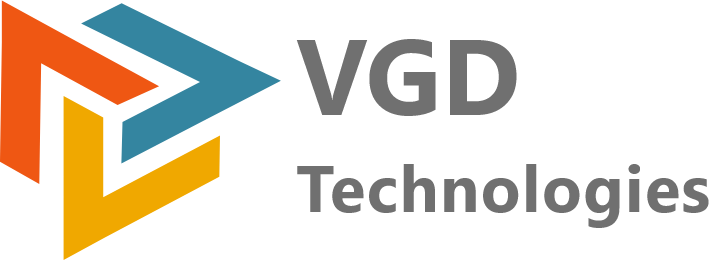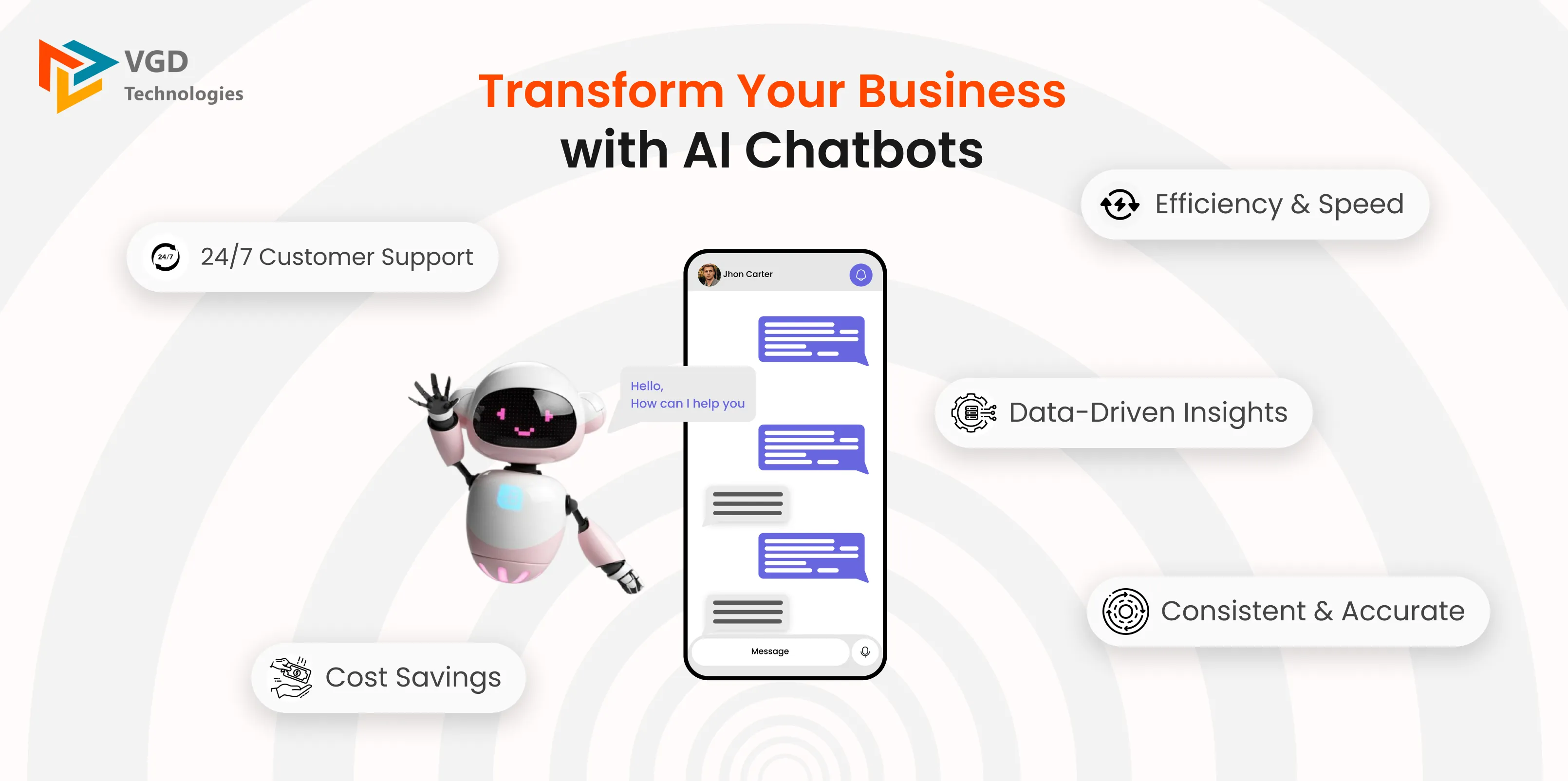How To Build Your First AI-Powered Chatbot
The business landscape is evolving rapidly, driven by technological advancements that boost competition across all sectors. Innovations like Artificial Intelligence (AI), Big Data, 5G, and the Internet of Things (IoT) have accelerated business growth, presenting both opportunities and challenges. Among these, AI-powered chatbots have emerged as a transformative tool for improving customer experience, reducing costs, and enhancing efficiency.
Investing in an AI-powered chatbot for your website can be crucial for staying competitive. With the chatbot market expected to exceed $1.25 billion by 2025, businesses are exploring how AI chatbots can streamline customer service, automate tasks, and drive sales.
This blog explores the benefits of AI chatbots, why your business should consider integrating one, and how companies like VGD Technologies can help you develop a custom AI chatbot solution.
What is an AI-powered chatbot?
An AI-powered chatbot is an intelligent software application that uses Artificial Intelligence (AI), Natural Language Processing (NLP), and machine learning algorithms to interact with users in a human-like manner. These chatbots understand and process natural language inputs, whether through text or voice, and provide accurate, context-aware responses.
For businesses, an AI chatbot can handle various tasks such as:
- Customer service: Answering queries, resolving issues, and providing support.
- Sales assistance: Offering product recommendations, upselling, and completing transactions.
- Data collection: Gathering customer insights to enhance marketing strategies.
Well-known AI chatbots include Google AI, Apple's Siri, and ChatGPT. These advanced AI systems represent the future of digital assistants and customer engagement.
Why You Should Build an AI Chatbot for Your Business
Here are several compelling reasons why investing in AI chatbot development can revolutionize your business:
1. 24/7 Customer Support
AI chatbots provide round-the-clock support, ensuring your customers receive assistance at any time. For example, Spotify's AI chatbot provides continuous assistance with tasks such as password resets and troubleshooting, reducing the need for human agents and saving costs.
2. Cost Savings
An AI chatbot is more affordable to deploy and maintain compared to hiring additional customer service agents. Aeromexico's chatbot, Aerobot, assists customers with flight status, bookings, and common inquiries, leading to a 30% reduction in calls to human agents.
3. Increased Sales and Lead Generation
AI chatbots can guide potential customers through the sales funnel, qualify leads, and suggest upsell opportunities. Pizza Hut's chatbot encourages customers to purchase additional items like desserts and drinks, contributing to higher average order values.
4. Enhanced Efficiency
AI chatbots can handle multiple conversations simultaneously without delays. HDFC Bank's Eva chatbot can instantly retrieve detailed customer information, such as transaction history and account data, allowing for faster responses and improved service.
5. Data-Driven Marketing Insights
AI chatbots collect and analyze customer interactions, providing valuable data to enhance your marketing efforts. Domino's pizza-ordering chatbot gathers data about customer preferences, peak order times, and popular combinations, allowing the company to optimize its offerings.
6. Consistency and Accuracy
Chatbots provide consistent, reliable responses every time. They don't get tired or distracted, ensuring customers always receive accurate information. The CDC's COVID-19 chatbot delivers consistent, fact-based answers about the virus, preventing misinformation.
7. Seamless Integration with Existing Systems
AI chatbots can be integrated with CRMs, calendars, knowledge bases, and other systems, allowing for a smooth, automated customer experience. Marriott International's chatbot integrates with hotel booking systems, making it easier for customers to book rooms and manage their stays.
Types of AI Chatbots
As AI technology advances, several types of chatbots have emerged, each tailored for specific tasks:
- Retrieval-Based Chatbots: Offer predefined responses based on a knowledge base, effective for simple, task-specific interactions like FAQs.
- Generative Chatbots: Use NLP and machine learning to understand and generate contextually relevant responses. Examples include Google Bard and ChatGPT.
- Task-Oriented Chatbots: Designed to perform specific tasks like booking appointments, making reservations, or processing orders.
- Conversational AI Assistants: Engage in free-form conversations and assist with complex queries across various domains, like Amazon Alexa or Google Assistant.
- Emotionally Intelligent Chatbots: Incorporate emotional AI to detect and respond to users' emotions, making interactions more personal and empathetic.
How VGD Technologies Can Help You Build an AI Chatbot
At VGD Technologies, we specialize in AI-powered chatbot development services to help businesses automate customer service, streamline sales, and boost customer engagement. Whether you need an enterprise AI chatbot development service or a smaller-scale solution for your website, our team of experts can guide you through the entire development process.
Key Features of Our AI Chatbot Development Services:
- Custom Solutions: Tailored to your business needs and goals.
- Multi-Channel Integration: Implement chatbots across websites, mobile apps, and social media platforms.
- NLP and Machine Learning: Ensuring your chatbot understands and responds accurately to customer queries.
- Scalability: Our chatbots are designed to grow with your business.
With VGD Technologies, you can integrate an AI-powered chatbot for your website, transforming how you engage with customers.
Building Your AI Chatbot: A Step-by-Step Guide
Here's a brief overview of the key steps involved in building an AI chatbot from scratch:
- Define the Purpose: Clearly outline your chatbot's role—customer support, lead generation, or sales assistance.
- Choose the Platform: Decide where your chatbot will interact with users—your website, mobile app, or social media channels.
- Select the Right Technology Stack: Choose frameworks like Google AI, Dialogflow, or IBM Watson.
- Create a Knowledge Base: Gather and organize relevant data for your chatbot to respond intelligently.
- Design the Chatbot Interface: Create a user-friendly interface that facilitates smooth conversations.
- Train the Chatbot: Use machine learning to fine-tune your chatbot, improving its understanding and responses over time.
- Integrate and Test: Test the chatbot to ensure functionality and smooth interaction before going live.
- Monitor and Improve: Continuously gather feedback and optimize the chatbot's performance.
How Much Does It Cost to Build an AI Chatbot?
The cost of developing an AI chatbot depends on several factors:
- Type of chatbot: Simple, rule-based chatbots are cheaper than complex, generative models.
- Development approach: Using pre-built tools like Google AI Studio may reduce costs, while custom development can be more expensive.
- Integration requirements: Integrating your chatbot with multiple systems adds complexity and cost.
- Training data: High-quality, extensive data for chatbot training impacts the overall cost.
At VGD Technologies, we offer AI development services that cater to different budgets, ensuring your business gets the most value out of your investment.
Conclusion
AI chatbots are a critical component of modern business strategy. From 24/7 customer service to lead generation and sales automation, AI-powered chatbots transform business operations. With companies like VGD Technologies, you can harness the power

